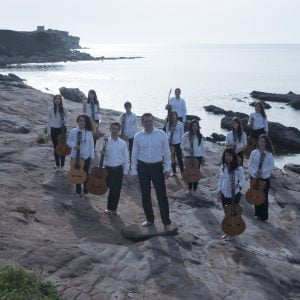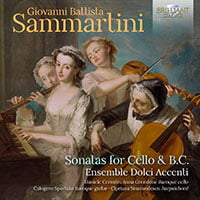Description
Johann Friedrich Ruhe (1699-1776)
Sonatas for viola da gamba and continuous bass
Daniele Cernuto viola da gamba
Calogero Sportato theorbo, archlute and Spanish guitar
Lorenzo Feder Harpsichord
Mauro Zavagno violone
To receive the CD, make a donation to the Dolci Accenti association
Little information about the chapel master of Magdeburg Cathedral has survived to this day. Born into a family of musicians, Johann Friedrich Ruhe was introduced to music by his father Johann Valentin. In the 1716 he continued his studies at the Lyceum Chaterineum in Braunschweig and in 1718 for a year and a half he became a member of the Wolfenbuttel court orchestra. In the 1720 studies philosophy and theology at the University of Braunschweig in Helmstedt. In the 1725 he was elected cantor at the church of S. of John, role he held for eight years. In the 1733 he applied for the role of Kapellmeister at Magdeburg Cathedral and School. The following year he was entrusted with the liturgy and choir of the church.
Despite these important roles he held as composer and Kapellmeister, Ruhe was forgotten after his death, occurred in 1776. If the documents relating to his life are fragmentary, there is even less news relating to his activity as a composer though, as known, there are many musical activities linked to the rites and devotions of the Protestant communities, Catholic works which involved a wide-ranging compositional activity.
The incomplete biography and the scarce sources of the time make the information on Ruhe's actual production uncertain. Impossible to calculate the works, lost compositions, sonata, symphony, concerts or sacred works that had to represent an important part of the creative aspect considering the great role that the composer had. Dal 1733, Indeed, he was Kapelmeister of the Magdeburg Cathedral and lasted during this long period 43 years his works were performed directly in manuscript form. For example, the contemporary and much more famous Telemann, who was also born in that city, suffered the same fate.
The only compositions that have survived to the present day are kept in the Greiz collection at the state archives of Thuringia.
The manuscript contains 4 Sonatas for viola da gamba and continuous bass and a suite for viola and cello. The date of the compositions is unknown, The period in which they will be included in Greiz's collection is not even known. The characteristics and compositional style allow us to date them approximately between 1740 and the 1750. In fact, the four sonatas represent the ferment that later materialized in the movement that arose in Mannheim in which the German and Italian styles effectively contributed to a structural and formal renewal with a more international scope..
The stylized marching rhythm of some fast tempos, typical of the Mannheim school, it is enriched with the careful use of the renda, especially in slow tempos, which gives it an attractive individuality, even if it sometimes hides the poverty of episodic developments. The melodic invention in the slow movements is also notable, which often reaches considerable amplitude. Thanks to a typically vocal writing, the melody retains its simplicity and is admired for the beauty of its expression, also enhanced by the different use of plucked instruments, sometimes combined with melodic bass instruments. The result is sometimes highly dramatic music, of tormented expressiveness in slow tempos. The canto dei tempi andante is graceful, alive and picturesque, the harmony is melodious, at times passionate and simple, although knowledgeable and is by these means, very simple, that Ruhe achieves great expressive and harmonious effects. From an instrumental point of view, in this recording we wanted to vary the timbral qualities of the different instruments as much as possible, although the instrumental roles are only one supported by the continuous bass. This allows us to enhance the compositional qualities of this forgotten composer and the listener is only asked to "be silent" to listen to him.
Two “par viola da gamba” sonatas are composed of three movements whose agogic tempos are classically alternated between slow moderate and allegro. The other two sonatas, Instead, they are divided into four movements and contain two slow and fast tempos alternately within them
Sonata II in A minor, opens this recording, with an Adagio tempo, very melancholic and nostalgic whose singability is enhanced by the theorbo and a melodic bass that supports the melody. The following Allegro, in addition to the solo instrument, sees the continuous bass section as a very protagonist with its own response phrases to the melody and small independent phrases and imitative dialogues. The third movement is a Minuet although long in duration, is alternated in the use of dynamic color instrumentation but also with an interesting change of key to A major in the final trio.
Sonata I in C major opens with a large Andante in 6/8 always very singable as rococo themes are often entrusted to some cello solo. The central Allegro makes use of repetitions and sometimes the bass joins the melody in a grand unison. The almost jaunty dance character of the Presto closes this sonata between continuous modulations and the use of double strings.
Wide arpeggios in G major open the Andante of Sonata III which delicately transform into descending leaps of a third, characterizing the entire movement, making it almost dance-like. L’ The next Allegro bursts in with its syncopated rhythms and shifted accents that make the tempo extremely lively. The following Adagio brings back a relaxed atmosphere, the harpsichord being silent makes the atmosphere softer and the use of the violone enriches the depth of the sound. The last Vivace from time in 3/8 closes the sonata. The pace is fast, punctuated and supports a melody built on small portions, but sometimes it opens up to broad progressions making it extremely musical.
The last sonata of this recording opens with a movement without agogic. The key of D minor develops through a slow headless arpeggio of the viola, almost like a prelude. The following Allegro sees the written use of the "octave key" in the score., making the rich harmonization required of the continuous bass lighter. But it is over time that Alla Siciliana also thanks to the use of the violone, the acciccatures present over time 6/8, and a skilful use of melody, make this movement singable and relaxed. The sonata ends with Un Poco Vivace which also features the basso continuo which dialogues in contrast with the solo line through its own part developed in a soloistic and original way.





Reviews
There are no reviews yet.